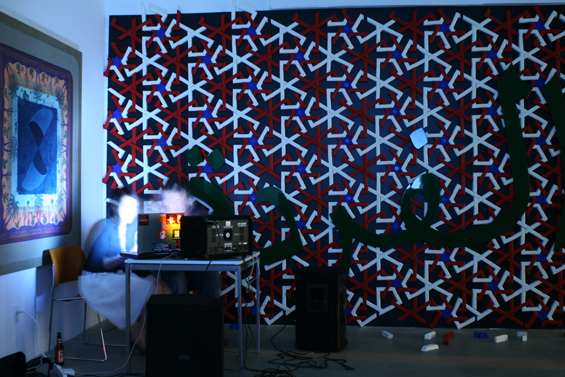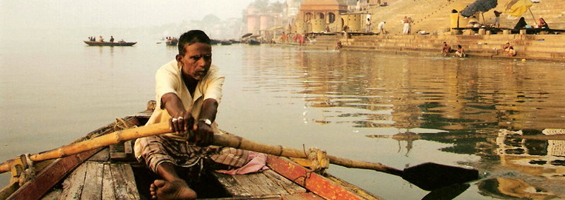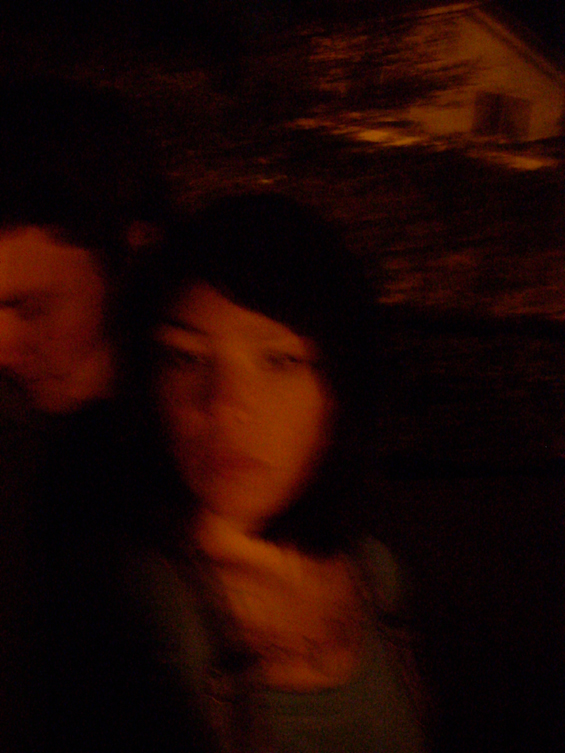

TEN QUESTIONS WITH CELER
Husband-and-wife duo Danielle Baquet-Long and Will Long—she a painter, writer, and teacher of special education and music therapy; he an educator and writer with a background in Creative Writing, Philosophy, and Literature—give new meaning to the word prolific. Since 2003, they've issued a staggering number of beautiful recordings, sometimes as self-released CDRs and sometimes on independent labels based in North America, Japan, and Europe (e.g., Spekk, Infraction, and/OAR). The two assemble their hypnotic, typically long-form ambient pieces from a rich assortment of field recordings (though they currently live on the coast of Southern California, they've lived nomadic lives too, with Danielle also having lived in India, Nepal, and Sri Lanka, and as such materials recorded at exotic locales find their way into the pair's pieces) and instruments, both of which are subjected to generous amounts of processing treatments to give the final works their celestial character. Will first began experimenting with sound at age four (creating “unsynchronized tape loops” by recording fragments from records and films onto audio cassettes) so it hardly surprises that the two are now such sophisticated practitioners of loop-oriented soundscaping. Recently the duo found a few moments to talk with textura about their working methods, track durations, and future projects, among other things (answers are by both Will and Dani unless otherwise specified).
1. How did the whole Celer project come about in the first place? Did the two of you meet and consciously decide upon a shared artistic project or did you naturally gravitate towards it?
We met in August 200, but lived in separate parts of the country until July 2006, and until then, were only very close friends. Through the years, we kept in close contact, through letters, but didn't start exchanging music until later, when we were actually living in the same place. When we started dating in 2006, we both decided to start recording, and playing music more. Before, there was a lot of experimenting with different techniques, but it was never taken seriously in any way. The most important and special thing about Celer is that it's something that we can do together, equally. Without that, it just wouldn't be the same. Since we live together, and can't write letters as easy anymore, we just make music for each other, together. It's all simply love letters.
2. The quality of the output from the beginning makes it seem as if Celer arrived fully-formed at the outset. Is that some sleight-of-hand trick or am I just not hearing the tentative growth steps that culminated in an accomplished recent work such as Mesoscaphe, for example?
When we started, things were meant to be special, to be unique and original, but we didn't really see it going to any specific place. The first few albums that we made, we just gave away to friends, but the responses were so warm, that we decided to try to attempt it on a larger scale. Musically, I think we had an idea of the equipment that we liked, and what it was that we wanted to hear. Many of our early experiments were also very improvised, in comparison to some more recent works, and especially works released by labels. Sometimes we just played, and let the pieces play on their own, and didn't stop them until their end felt that it had appeared, and the sounds just felt right.
3. As you generally work as a duo, I'm wondering how you found the experience of collaborating with Matthieu Ruhlmann on Mesoscaphe? Did doing so lead to a change in your own working methods? Are there other collaborations on the horizon or was it a one-off kind of project?
Will: Working with Mathieu has been a great experience. We really have loved the ‘true collaboration' kind of work, that we have been able to do together. Just with the success through sound exchange, remix, exchange, and mix, it came to be a really special way to collaborate. It's not always just the working methods that is so exciting about collaborating, but the ability to work with completely new sounds and concepts. Bringing some light to the story of the Mesoscaphe was a really meaningful experience, even just doing the research and learning more about it was a great part of it. We were also able to work with the wonderful people at Spekk, which couldn't have been a better experience. With the album finally being accepted into the archives of the Mesoscaphe at the Vancouver Maritime Museum, it became something even more special.
There are other collaborations in the future, including a current second collaboration with Mathieu Ruhlmann, another with Yui Onodera of Japan, another with Antti Rannisto of Finland, and a few more later.
4. Despite the fact that so many of your recordings originate from diverse materials, there's ultimately a common thread running through them, specifically a celestial character and an understated purity. I can't help but hear it as a Plato-like trajectory from the particular to the universal, as if you're attempting to move up Plato's Divided Line to ascend closer to the transcendental peak that is its uppermost limit. Is that an accurate characterization or way off the mark?
Will: Maybe there will be an ultimate climax, similar to how we used to write letters to each other, ultimately ending up together, then married. Even though we have things planned for the future, there isn't really anything definite of what will really happen. We would hope that with each work, it presents a new example of where we are, where we are going, and what we're feeling. There's a lot of romanticism inside the whole process, with a bit of randomness and unexpected improvisations. Everything is so much easy with love as the center, even though unexpected, and uncertain how long anything will last. Everything should always be cared for with the most tenderness, as if it could disappear at any moment.
5. Relatedly, your stated intent is to “produce works that reflect the nature of love, family, and their concerns and interests, through a relative and absolute symposium of expression.” Could you elaborate on the “relative and absolute symposium of expression” idea (which, again, understandably hints at a Plato connection in The Symposium reference whose focus is, likewise, love), and secondly discuss the extent to which the intent is realizable through instrumental musical works that are largely non-referential and ultimately abstract?
The emotional element is our initial priority. After spending so many years creating a figurative relationship, our closeness has derived a sound. It's the importance of subtlety, just the random thoughts and feelings, and those which you pick out to make into something more. So often we re-live experiences through memories, and just repeating them. We just want to soundtrack that, translating those movements, emotions, and experiences into sounds of our own. Some of it seems somewhat fantasy-like, such as creating a beautiful symphony that is symbolic of a lost love. Instead we want things to be more immediate, and not just a memory, but actually repeating the experience, by getting down to the primal feelings. Eventually we'd like to be able to create absolute realism, that is more of a re-creation of an experience, than simply a musical equivalent.
Even though most of our works are covered in expansive though sometimes vague concepts, the underlying theme throughout everything is love. Without making things too simple, everything remains very complex and subtly natural. Pieces will include multiple movements, or changes, somewhat like brush strokes that have a sound. It's simply replacing what is left muted on film, left to be seen with the eye: soft movements, and what is lying behind them.

6. Given your propensity for global travel and in particular your affinity for countries such as India, Nepal, and Sri Lanka, I'm curious as to how that dimension of your experience manifests itself in your music. (Discourses of the Withered and The Everything and the Nothing , for example, are said to be centered on Dani's travels in India and Nepal). I don't mean necessarily literally—we hear occasional field recordings from those locales in The Everything and the Nothing—but on a deeper level.
Dani: While living in India I made several field recordings on a mini-cassette with the intention of capturing teachings and lectures. What came of the recordings were raw and indecipherable collections of several languages and the sounds of the city life. Those sat in storage until many years later when my affinity for creating ambient sounds ascended. When I started to have my India, Nepal, and Sri Lanka photos developed I realized two things: one, it's hard to take a bad photo in any of those places and two, there's something missing. Listening back to those recordings I realized that what the photos lacked were that raw-ness, that almost ability to smell, hear, feel everything around you. This is when I became fascinated with the intensity of recordings; what they capture in the most profound and immediate sensory experiences, when images and words can't make you smell and feel. The surrounding music was meant to simply capture the heavy weight and emotional imagery of the photographs, from what I saw, felt, and heard.
7. On the one hand, you appear to exercise immense control over the recorded material, yet on the other hand you also seem to embrace the chance and generative side of the process. For example, when mixing the loops for Nacreous Clouds, by your own admission you “played three to six of them at a time, on different reel-to-reel tape players connected to both of (your) laptops and channeled back out into a Kaiser filter.” Could you talk a bit about how much you like to retain control versus how much you're committed to relinquishing it?
With Nacreous Clouds, we watched hours of footage of the clouds while preparing the album, which we had already created much of the music for. We wanted to really mimic the movements of the clouds as closely as possible to the structure of the sounds. When we finally sat down to record the individual tracks, it took a bit of arranging as far as synchronization, just when the movements sounded best mixed, but ultimately those particularly-arranged pieces changed soon after we pressed play, mixing on their own without our control. Even though we would have liked to have complete control over the sound, it wasn't even close the actual clouds' behaviors. Letting the loops mix themselves, while under short restraints, allowed them to appear and disappear, just like the colours of the clouds. With all other projects, it always depends, though we're always open to accident.

8. What determines track duration for you? On I Love You So Much I Can't Even Title This (The Light That Never Goes Out Went Out) , there are two ten-minute pieces and one forty-minute. What dictates that “The Delay of Intolerance,” for example, should be forty minutes and not thirty or fifty? Given the time-suspending nature of the material, it could, in theory, carry on without end couldn't it?
Track duration always seems to be very dependent upon the work in particular, and very seldom do we have any particular length in mind when actually recording. It's usually during mixing that lengths become more apparent, just through arrangement, and true feeling of the sounds. Typically with longer pieces of developing loops, represented in many of our early self releases (Sunlir / Scols, Sadha), the pieces were simply switched on, and allowed to mix entirely on their own, with little interaction from us. We would simply stop them once we felt the piece had reached a comfortable duration.
On the I Love You So Much I Can't Even Title This album, we had initially only planned to have two tracks, which were the two shorter ones. “The Delay of Intolerance” actually came from an overlooked recording of the string quartet warming up with random notes from one of Barber's piano works. With two previously built tracks that were very similar in structure, we wanted to close the disc with something different, as it was also of a different compositional quality. We took that one short segment of music, and re-arranged it, mixing it in a live form, slowly modifying it to a peak. The entire piece was meant to move and shift sort of as if you were driving up a mountain. You start at the bottom, and slowly circle, ascending. At one point you reach the top, and begin a descent. Instead of ending at the peak, we decided to take the listener through the descent as well. In the end, we wanted to the listener to actually experience the full journey. There are beautiful things to be seen on the way down, even if it feels the same.
9. You cite a huge number of influences at your MySpace site but I'm curious as to which two or three figures have had the greatest influence on your work, musical or otherwise. Tell us in what way they've influenced you too.
Will: Charlie Chaplin has been an influence of mine since I was very young. His films, musical compositions, and expression of emotion have always been very special to me. His ability to give true feelings through expressions, and carefree movement of the heart, always left a defined impression on me. Even though his films are a huge influence, so is his personal life, as heartbreaking as parts of it were. So are many times, but love always remains close.
Dani: As contradictory as it may seem, my inspiration comes from the poets Kenneth and Miriam Patchen. William and I have a very extensive history and friendship, mostly manifested in long letters filled with text, and almost overwhelming prose. My favourite poet, Kenneth Patchen dedicated everything he ever wrote to his wife, Miriam.
10. What does the future hold for Celer with respect to recordings, live appearances, etc.?
Late this year we should have a release on Slow Flow, a new small label from Sapporo, Japan, run by ryonkt; a cassette on Digitalis Limited, and the 50th release on the Belgian label Mystery Sea.In 2009 we should have another release on and/OAR, a double album on Infraction Records, a release on Japan's Commune Disc, a release on Gears of Sand (as well as a Chubby Wolf solo album, Dani's side project).
As already mentioned, we are also working on a few collaborations, including a second with Mathieu Ruhlmann, a work with Yui Onodera of Japan , an audio/visual work with Tony Obr (Tsone) of Arizona , and another work with Antti Rannisto of Finland.
As usual there should be a few new handmade releases peppered through time, as always.
November 2008![]()